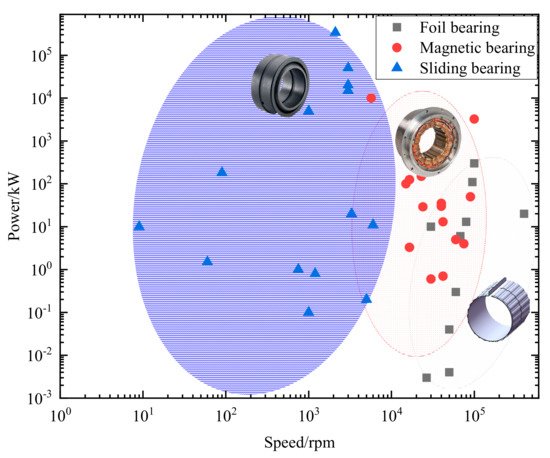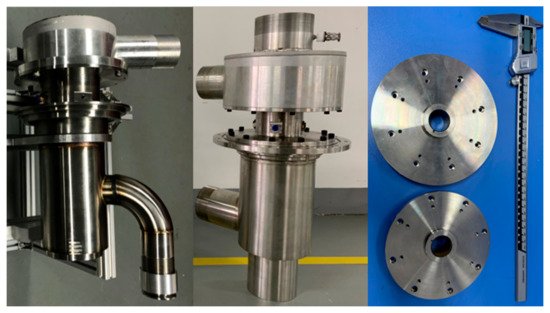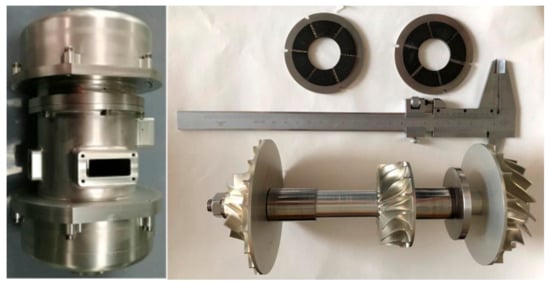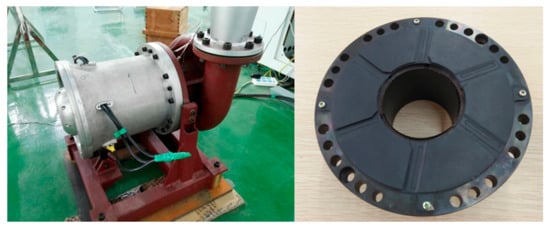Gas foil bearing has been widely used in high-speed turbo machinery due to its oil-free, wide temperature range, low cost, high adaptability, high stability and environmental friendliness. In this paper, state-of-the-art investigations of gas foil bearings are reviewed, mainly on the development of the high-speed turbo machinery in China. After decades of development, progress has been achieved in the field of gas foil bearing in China. Small-scale applications of gas foil bearing have been realized in a variety of high-speed turbo machinery. The prospects and markets of high-speed turbo machinery are very broad. Various high-speed turbomachines with gas foil bearings have been developed. Due to the different application occasions, higher reliability requirements are imposed on the foil bearing technology. Therefore, its design principle, theory, and manufacturing technology should be adaptive to new application occasions before mass production. Thus, there are still a number of inherent challenges that must be addressed, for example, thermal management, rotor-dynamic stability and wear-resistant coatings.
1. Introduction
Gas foil bearing has the distinct advantages of cleanliness, low friction, low temperature rise, and cost effectiveness
[1]. These advantages make it applicable in most advanced turbo machinery systems, for instance, aerospace, energy and power engineering, etc.
[2][3][4].
Compared with sliding bearing and ball bearing, gas foil bearings have a high running speed and a wider operating range, from tens of thousands rpm (round per minute) to hundreds of thousands rpm. Its power ranges from several kilowatts to more than 100 kilowatts, as shown in
Figure 1. It is especially suitable for micro–small high-power density turbo machinery, such as fuel cell air compressors, turbo-expanders, oil-free turbochargers, etc. In comparison, sliding bearings are favored to be used in low-speed applications due to their oil lubricating properties, which are an important support component in large capacity power machinery
[5]. As for magnetic bearings, their speed is between that of foil bearings and sliding bearings. Most are used in turbine generator, aeroengine, high-speed CNC (computer numerical control) machine tools, wind power equipment and other cases.
Figure 1. Application range of different kinds bearings.
For gas foil bearings, their stability and reliability depend largely on elastic support. Under the elastic top foil, an elastic supporting structure provides additional damping, which conforms to the variable load and speed
[6]. Through the damping effect, vibration energy can be absorbed due to Coulomb friction dissipation between the foils and bearing housing. Even if there is impact force or unstable whirl motion, the rotor maintains its stability
[7].
In order to improve the bearing performance, different types of gas foil bearings have been proposed. According to the underlying elastic structure, the most-used gas foil bearings are bump foil type, multi-leaf type, protuberant type, and so on
[8]. The lubrication mechanisms of a gas foil journal and thrust bearings are basically the same. Herein, a gas foil journal bearing is chosen as an illustration, shown in
Figure 2. The basic structure of a bump foil bearing is shown in
Figure 2a
[9], which consists of a flexible flat foil and an elastic bump foil. The bumps of the supporting foil are evenly distributed along the circumferential direction. The top foil is stacked over corrugated foil, and both foils are fixed at one end and are free at the other end. As for multi-leaf foil bearing, it is composed of a bearing housing and several cantilever foils
[10], as shown in
Figure 2b. The leading edge of the cantilever foil is fixed in the bearing, while the trailing edge is freely overlapped on the next cantilever foil. The extension direction of the cantilever foil is consistent with the rotation direction of the rotor. A wire can also be used for elastic support. In the wire supporting foil bearing, a certain number of copper wires are fixed on the back of the foil, as shown in
Figure 2c
[11]. The rigidity of the foil element can be adjusted by changing the number of copper wires and thicknesses of the copper wires. A viscoelastic supporting gas foil bearing is another kind of foil bearing, as shown in
Figure 2d. In 1999, the Institute of Refrigeration and Cryogenics of Xi’an Jiaotong University proposed a viscoelastic supporting gas foil bearing
[12]. The foil element is a combination of a metal foil and a piece of viscoelastic supporting sheet. The spring supported foil bearing is a new type of foil bearing, as shown in
Figure 2e. Hunan University presented a theoretical and experimental study on a novel nested compression spring
[13][14]. The stiffness and damping of the support can be adjusted by varying the number and size of springs. In the protuberant foil structure, as shown in
Figure 2f, there are multiple layers of protuberant foil between the top foil and the bearing housing
[15]. The supporting foil element is composed of a top foil and two protuberant foils. In the assembly process, the bearing performance and stability of the bearing can be improved and the wear on the bearing surface is reduced due to the effective elastic pre-deformation of the protuberant foils
[16][17].
Figure 2. Typical gas foil journal bearings. (a) bump foil bearing; (b) multi-leaf foil bearing; (c) wire supporting foil bearing; (d) viscoelastic supporting gas foil bearing; (e) spring supported foil bearing; (f) protuberant foil bearing.
2. Applications of Gas Foil Bearings
2.1. Application in Low Temperature High-Speed Turbo-Expander
The working temperature of a cryogenic expander is always lower than 120 Kelvin. In order to enlarge the mass flow rate and maintain a relatively high adiabatic efficiency, its rotor needs to run at a high speed under low temperatures. By using the gas foil bearing, the unstable whirl motion of the rotor bearing system can be suppressed and effectively attenuated. Its stability and reliability can be improved notably. In the 1990s, theoretical and experimental research on air foil bearings for turbo-expanders was initiated by the Institute of Refrigeration and Cryogenics of Xi’an Jiaotong University. The rated air volume of the turbo-expander is 600 Nm
3/h@1.15 MPa, and it can work between 0–110 krpm (overspeed to 150 krpm) according to the air supply pressure
[18]. The research work on the wire support, viscoelastic support, bump foil support, protuberant support, and multi-leaf foil bearings has been carried out successively, and some progress has been made.
In China, foil bearings were first used in cryogenic turbo-expanders, and then gradually extended to other fields. In 1998, a wire support elastic structure foil bearing was first proposed
[19]. In the experiment, a stable speed of 120 krpm or more was reached, and the maximum amplitude was less than 12 μm. The experimental results showed that the turbo-expander ran smoothly at an overspeed of 120% at 118 krpm. In 1999, a turbo-expander supported by viscoelastic foil bearings achieved an excellent performance of 40% over-speeding at 148 krpm
[20]. The test used MoS2 powder and two methods of plating Cr and Tic to enhance the hardness of the foil, and over 50 start–stop performance tests were carried out. The test results showed that the surface-treated elastic foil thrust bearing had better start–stop performance and stability. The Institute of Refrigeration and Cryogenics of Xi’an Jiaotong University also conducted a theoretical study on viscoelastic foil bearings
[21] and compared the experimental results with wire supported foil bearings. It was found that the stiffness distribution of the viscoelastic bearings was more uniform and had a better stability during ultra-high-speed operations
[22]. In 2006, considering the influence of friction, a simplified formula of structural stiffness was obtained, and the structural stiffness of bump foil bearing was analyzed
[23]. By comparing two types of foil journal bearings with foil thicknesses of 0.05 mm and 0.07 mm, the vibration characteristics and stability of a turbo-expander were studied. The maximum speed of the turbo-expander using 0.05-mm bump foil bearings was 93,336 rpm. For the turbo-expander using a 0.07-mm bump foil bearing, rotor whirl motion appeared when its maximum speed reached 93,161 rpm. The results showed that when the turbo-expander reached 93 krpm, the maximum amplitude of the rotor was less than 20 μm
[24]. In 2012, in order to analyze the feasibility of the application of protuberant foil journal bearings in a turbo-expander, another experimental study was carried out. The results showed that the maximum speed of the turbo-expander reached 99,044 rpm, and the low-frequency whirl motion was small during the entire speed-up and speed-down process
[25][26][27]. In the total protuberant foil bearing test (both journal and thrust bearings are protuberant type), the gas foil bearing ran smoothly and had high repeatability during the operation of the turbo-expander
[15]. Subsequently, the multi-leaf foil journal bearing and thrust bearing were simultaneously applied to this high-speed turbo-expander. Transient acceleration and high-speed operation tests of the rotor bearing system were carried out, and the transient characteristics and the stability of the rotor bearing system were analyzed. The experimental results showed that the starting friction torque and running resistance torque of the multi-leaf foil journal bearings were small, and the turbo-expander could reach 93,900 rpm. The rotor bearing system had the advantages of a smaller main frequency amplitude (<6 μm) and a low frequency whirl amplitude (<0.5 μm). The rotor locus was clear and had good repeatability
[28][29]. For a cryogenic working fluid turboexpander, as shown in the
Figure 3, a helium turbo-expander (500 W) supported by foil journal bearings was designed with a rated speed of 220 krpm. The speed could exceed the design speed by 12% in the test with a normal air temperature. In addition, a series of hydrogen turbo-expanders supported by gas foil journal bearings was also developed, with power ranging from more than 20 to 40 kW. The turbo-expander (39.7 kW) with a rated speed of 74.5 krpm was tested in an air environment. The speed could reach 60 krpm, and the amplitude was less than 0.023 μm. Due to their large thrust force, hydrostatic bearings are currently used as thrust bearings in hydrogen and helium turbo-expanders. Meanwhile, a carbon dioxide turbo expander with a rated speed of 125,000 rpm has been designed, as shown in
Figure 4. Its rated speed could reach 80,722 rpm in the experiment. The inlet and outlet pressures of the turbo expander were 10 MPa and 7.3 MPa, respectively.
Figure 3. Helium turbo-expander and hydrogen turbo-expander by Xi’an Jiaotong University.
Figure 4. CO2 turbo-expander by Xi’an Jiaotong University.
2.2. Application in Air Cycle Machine (ACM)
An air cycle machine is always used to adjust the environment in an aircraft cabin, which is the core component of the air conditioning system. It is also widely used in armored vehicles abroad for their high reliability, long service life, and oil-free characteristics. Rotor systems with gas foil bearings have become popular. At present, the main domestic research institutions engaged in ACM research are the Institute of Refrigeration and Cryogenics of Xi’an Jiaotong University, the 16th Research Institute of China Electronics Technology Group Corporation, Hunan University, and other institutions.
Since 2014, domestic research work has been carried out on the ACM system, and some progress has been made. The Institute of Refrigeration and Cryogenics of Xi’an Jiaotong University developed an airborne turbo cooler supported by gas foil bearings
[30]. The structure of airborne turbo cooler is shown in
Figure 5. The rotor mass is 900 g and the rated speed is 40 krpm. A series of tests have been carried out on its low temperature repeating start–stop and reliability performances. In vibration tests and extreme temperature (−55 °C and 70 °C) start-up tests, its performance was better than expectations. In the tests, the coating did not peel off after a hundred start–stop and over-speed operations. In addition, a 13-kW ACM supported by gas foil bearings was designed and developed by Hunan University, and experimental research was conducted on its rotor bearing system
[31]. The critical speed and unbalanced response of the ACM rotor bearing system were analyzed, and the structural parameters of the rotor bearing system were modified according to the analyses. The vibration amplitude of the prototype rotor was finally reduced to about 10 μm. In addition, a performance test on the turbo cooler prototype with foil bearings was conducted by Deng
[32]. After 10,000 start–stop life tests and vibration tests, it was found that this machine had a good working performance. So far, the total running hours of this type of turbo cooler exceeded 1000 h.
Figure 5. Airborne turbo cooler by Xi’an Jiaotong University
[30].
2.3. Application in Centrifugal Blowers
The centrifugal blowers are important in industrial ventilation, which are widely used in many situations, such as medical, chemical, and sewage treatment. Due to the advantages of the high adaptability of the gas foil bearings, the service life and reliability of the blowers are greatly improved under extreme conditions, such as in a dusty environment. On the other hand, blower with gas foil bearings have the merits of low noise, high efficiency, and no pollution. In view of above advantages, centrifugal blowers supported by gas foil bearings have become the first choice for energy-efficient blower. Since the 1970s, foreign blower companies have tried to apply foil bearings in centrifugal blowers. By the end of the last century, highly efficient, energy-saving and highly integrated gas foil bearing blower products have come out on the market. Although domestic theoretical research on gas foil bearings has already been carried out, due to constraints such as materials and process levels, mature products are not yet available on the market. The main domestic research work in this area is the Institute of Machinery Manufacturing Technology, CAEP (China Academy of Engineering Physics) and Shijiazhuang Kingston Bearing Company. Shu X J developed a high-speed air foil bearing with a load capacity of 12.5 kg and tested the bearing performance
[33]. By assembling air foil bearings, high-speed motors, and fan impellers, a prototype centrifugal blower was designed and manufactured. The centrifugal blower is shown in
Figure 6. The diameter of the rotor is 80 mm and the maximum speed of the original machine is 30 krpm.
Figure 6. Centrifugal blower by the Institute of Machinery Manufacturing Technology, CAEP
[33].






